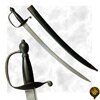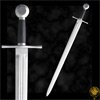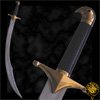|
|
|
 |
|
| Hanwei Raptor Tanto (SH2423) |
Points: 10

|
While the Wakizashi and Tanto of the Raptor series provide matching pieces for any of the Raptor katanas, they are in their own right designed as very effective cutting tools.
|
|
|
|
|
|
 |
|
| Hanwei Raptor Unokubi Zukuri Katana (SH2415) |
Points: 15

|
The Raptor Unokubi-Zukuri (Cormorants Neck) blade design is patterned after the shape of the Naginata, the powerful long-handled weapon popular between the 12th and 14th centuries. Notable for the strongly relieved shinogi-ji and diamond-shaped kissaki, the Unokubi-Zukuri provides excellent balance in a strong cutting blade.
The blade of the Raptor katana is hand forged in 5160 high carbon steel and is specifically heat treated to produce very high resilience and greater tolerance to misdirected cuts than a conventionally differentially tempered blade.
The blade geometry is configured to facilitate the cutting of both soft and semi hard materials without chipping, allowing the user a wider range of targets.
Cotton wrapped tsuka.
Tsuba, fuchi and kashira features a beautiful Raptor motif.
Black matte finish wood saya.
Comes with black sword bag.
|
|
|
|
|
|
 |
|
| Hanwei Raptor Wakizashi (SH2422) |
Points: 23

|
While the Wakizashi and Tanto of the Raptor series provide matching pieces for any of the Raptor katanas, they are in their own right designed as very effective cutting tools.
|
|
|
|
|
|
 |
|
| Hanwei Renaissance Style Swept Hilt Rapier (SH1024) |
Points: 12

|
Our Renaissance-style Swept Hilt Rapiers trace their origins to early 17th century Europe, where swordplay with the Rapier was considered an essential part of a gentleman's education and was often used in resolving gentlemanly disagreements. Blades generally originated in one of the blade making centers such as Toledo or Solingen, but many differences in styling and hilt materials resulted from the local manufacture of hilts all over Europe. The Main Gauche, or left hand dagger, was often used with the rapier, providing an added dimension in both offense and defense, and the "Schools of Fence" which proliferated in Europe during this period taught the use of the two weapons in combination. The Main Gauche would often match the Rapier in styling, while incorporating features which maximized the effectiveness of the piece.
|
|
|
|
|
|
 |
|
|
|
|
 |
|
| Hanwei Revolutionary War Hanger (SH2375) |
Points: 13
|
Based on an original of the period, our Revolutionary War Hanger (or Cutte) is accurately sized and antiqued to replicate a museum piece. The fully tempered, blunt edged, high carbon steel blade has a distal taper, with fullers on both sides along the spine, and is light and quick. The hilt fittings are cast in solid steel, matching the locket and chape of the leather-covered scabbard.
|
|
|
|
|
|
 |
|
| Hanwei River Witham Sword (SH2372) |
Points: 11

|
The River Witham Sword was dredged from the River Witham near the town of Lincoln during work carried out in 1788. The sword may be a remnant of the Battle of Lincoln in 1141; however, it was most likely constructed between 1250-1300 CE. The inscription on the blade reads +NDXOXCHMDRCHDXORVI+. Iberia Swords are crafted in much the same way as swords were made centuries ago, except that the blades are now forged from high-carbon spring steel, a resource unavailable off-the-shelf to the smiths of the old. The blade finish is far from being polished, again more closely replicating what the medieval swordsmith was able to achieve. Except as noted, grips are leather-covered hardwood. Fittings are either steel or solid brass. Except, where shown all of these swords have scabbards of leather-covered wood with steel lockets and chapes and removable suspension rings. These swords will appeal to the re-enactor who wants a sword with the same appearance as the originals.
|
|
|
|
|
|
 |
|
| Hanwei Ronin Katana (SH2360) |
Points: 50

|
The Story of the 47 Ronin is one of the most celebrated and influential tales of the Samurai from the Edo period. Lord Asano was a powerful Daimyo ordered by the Shogun to entertain guests of the Imperial Family. The highest ranking master of protocol, Kira, was given the task of teaching Asano, among others, proper matters of etiquette in this task. Lord Asano and Kira quickly grew to dislike each other and the teacher insulted his student at every opportunity. No longer able to contain himself, Asano drew his sword upon Kira, wounding him in the attack. This act led to Asano's ordered suicide (seppuku) and the confiscation of his property. On December 14, 1702, nearly one year after Asano's death, 47 of Asano's men (now Ronin), descended upon the mansion of Kira to exact their revenge.
|
|
|
|
|
|
 |
|
| Hanwei Saxon Sword 9th century (SH2436) |
Points: 25

|
CAS Hanwei’s smiths have outdone themselves with their recreation of a 9th Century Saxon sword by replicating a technique used by the Saxons and Vikings and producing a stunning blade that features a pattern-welded core with high-carbon edge sections. This technique was used by the old-time smiths as a means of producing blades (just for the rich folks) that were sharp, resilient and decorative and, eleven hundred years on, CAS Hanwei has made them affordable.
The sword’s design is based on a 9th Century piece found in the bank of a stream in England in 1976 and now on display in the Yorkshire Museum.
|
|
|
|
|
|
 |
|
| Hanwei Scimitar (SH2354) |
Points: 10
|
The deeply curved blade of the Scimitar recalls battles between the Saracen and Crusader. The hardwood grips and hawksbill pommel are typical of the originals and create the perfect balance that makes this piece essential equipment for Eastern dance practitioners.
|
|
|
|
|
|
 |
|
| Hanwei Scottish Basket Hilt Backsword (SH2003) |
Points: 24
|
Early highland swords almost invariably carried the double-edged "broadsword" blade, but by the time of the Battle of Culloden (1746) the single-edged "backsword" was at least equal in popularity.Our Basket-Hilt Backsword, replicated from an original in the collection of the Royal Armouries in England that dates from about 1760, has an unusual basket with twin engraved "horned beastie" plaques and a blade with twin fullers running most of its length. The blade is German in origin, but the hilt and blade are contemporary.
|
|
|
|
|
|
 |
|
| Hanwei Scottish Basket Hilt Broadsword (SH2002) |
Points: 15
|
Although Basket-Hilt swords appeared throughout Britain from the mid-sixteenth century on, their association with the seventeenth and eighteenth century Scottish highlander has become legendary.
Our Basket-Hilt Broadsword, replicated from an original in the collection of the Royal Armouries in England, carries a typical Glasgow-style hilt from the mid-18th century. It is likely that the blade of the original sword, marked "Andrea Ferara", was made in Germany a century earlier and re-hilted as basket designs were refined.
|
|
|
|
|
|
 |
|
| Hanwei Scottish Claymore (SH2060) |
Points: 12

|
Mainstay of the Highland warriors of the late 15th and 16th centuries, the Claymore had a uniquely styled hilt that sets it apart from other great swords of the period. Typically of hand-and-a-half length, this versatile weapon could deliver great sweeping slashes or powerful thrusts. Replicated from a surviving museum piece our Claymore (SH2060) is classic in its design, with distinctive sloping quillons terminating in quatrefoils and a high-collared quillon block with langets following the blade fuller. The leather-covered grip is topped by a globate pommel. Originally carried slung on the back, the Claymore matches perfectly with our OL1038B back scabbard.
Authentic styling
Fully functional
Excellent balance
|
|
|
|
|
|
 |
|
| Hanwei Scottish Claymore (SH2060N) |
Points: 18
|
Mainstay of the Highland warriors of the late 15th and 16th centuries, the Claymore had a uniquely styled hilt that sets it apart from other great swords of the period. Typically of hand-and-a-half length, this versatile weapon could deliver great sweeping slashes or powerful thrusts. Replicated from a surviving museum piece our Claymore is classic in its design, with distinctive sloping quillons terminating in quatrefoils and a high-collared quillon block with langets following the blade fuller. The leather-covered grip is topped by a globate pommel. The sword is available in both polished and antiqued finishes, the finish of the SH2060N closely replicating that of the original museum piece. The grips of the Claymore are leather-covered, black in the case of the SH2060 and brown for the SH2060N. Originally carried slung on the back, the Claymore matches perfectly with our OL1038/OL1038B back scabbard.
|
|
|
|
|
|
 |
|
| Hanwei Scottish Court Sword (SH1214) |
Points: 12

|
Quick and elegant describe the Scottish Court Sword. Replicating an original dating from the 1730's and belonging to an officer in Prince Charles Edward Stuart's army at Culloden, the finely chiseled silver-plated hilt and three-edged hollow ground blade exemplify the consummate skill of the swordsmiths of the period. See model SH2324 for the Practical Fencing Court Sword.
|
|
|
|
|
|
|
|
Tags:
swords, sword, katana, wakizashi, tanto, japanese sword, medieval sword, viking sword, japanese swords, medieval swords, viking swords, knife, knives, saber, armour, movie swords, movie replicas, martial arts, sporting goods, sporting equipment,
|













